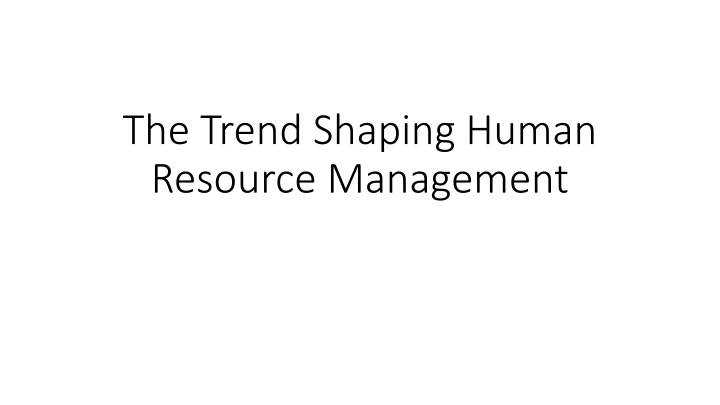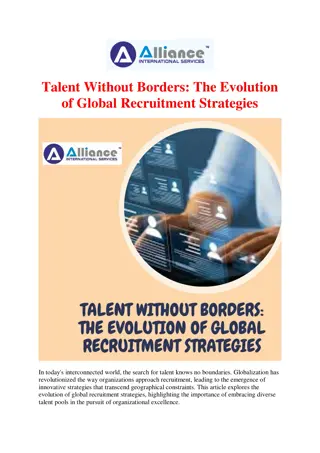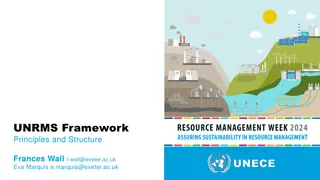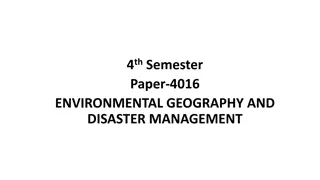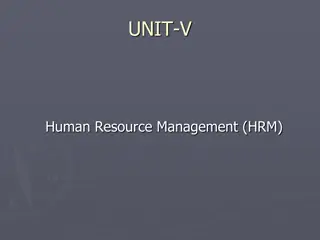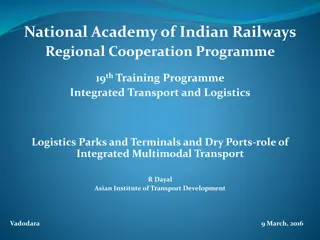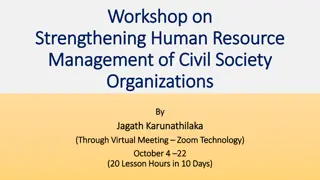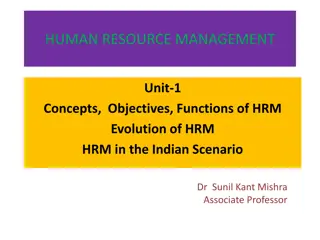The Changing Landscape of Human Resource Management in a Globalized World
Human resource management is evolving due to trends such as globalization, technology, deregulation, and economic challenges. Companies are expanding abroad to tap into new markets and partnerships, leading to increased competition and the need for world-class operations to lower costs. Globalization brings both benefits and threats, affecting consumers with lower prices and workers with higher productivity demands and potentially less secure jobs.
Download Presentation

Please find below an Image/Link to download the presentation.
The content on the website is provided AS IS for your information and personal use only. It may not be sold, licensed, or shared on other websites without obtaining consent from the author.If you encounter any issues during the download, it is possible that the publisher has removed the file from their server.
You are allowed to download the files provided on this website for personal or commercial use, subject to the condition that they are used lawfully. All files are the property of their respective owners.
The content on the website is provided AS IS for your information and personal use only. It may not be sold, licensed, or shared on other websites without obtaining consent from the author.
E N D
Presentation Transcript
The Trend Shaping Human Resource Management
The Trend Shaping Human Resource Management What human resource managers do and how they do it is changing. Some of the reason for these changes are obvious. One is Technology. For example, employers now use their intranets to let employees change their own benefits plans, something obviously couldn t do years ago. Other trends shaping human resource management include Globalization, Deregulation, Changes in Demographics and nature of the work, and economic challenges.
TRENDS Globalization and Competition Trends : Globalization refers to the tendency of firms to extend their sales, ownership, and /or manufacturing to new markets abroad. Examples : Toyota produces the Camry in Kentucky, while Dell produces PCs in China. Free trade areas agreements that reduce tariffs and barriers among trading partners further encourage international trade. NAFTA ( the North American Free Trade Agreement) and the EU (European Union) are examples.
Companies expand abroad for several reasons. Sales expansion is one. Walmart is opening stores in South America. Dell, knowing that China will soon be the World s biggest market for PC s is aggressively selling there. Firms go abroad for other reasons. Some manufacturers seek new foreign products and services to sell, and to cut labor costs. Some apparels manufacturers design and cut fabrics in Miami, and then assemble the actual products in Central America, where labor costs are relatively low.
Sometimes, its the prospect of forming partnerships that drives firms to do abroad. For Business people, globalization means more competition, and more competition means more pressure to be world-class to lower costs to make employees more productive and to do things better and less expensively. As one experts put it, the bottom line is that the growing integration of the world economy into a single, huge market place is increasing the intensity of competition in a wide range of manufacturing and service industries. Both workers and companies have to work harder and smarter than they did without globalization.
globalization therefore brings both benefits and threats. For consumers it means lower prices and higher quality on products on computers to cars, but for workers it means the prospects of working harder, and perhaps less secure jobs.
Indebtedness (leverage) and Deregulation: Other trends contributed to this economic growth. Deregulation was one. In many countries, governments stripped away regulations. In the United States and Europe, for instance, the rules that prevented commercial banks from expanding into stock brokering were relaxed. Giant, multinational financial supermarkets such as Citybank quickly emerged. As economies boomed, more business and consumers went deeply into debt.
Home buyers bought homes, with little money down. Banks freely lent money to developers to build more homes. For almost twenty years, U.S consumers actually spent more than they earned. On a Grander scale, the U.S itself increasingly became a debtor nation. Technological Trends : Everyone knows that technology changed almost everything we do. We use smart phones and ipads to communicate with the office and to plan trips, manage money and look for local eateries.
We also increasingly use technology for many human resource management type applications, such as looking for jobs. Face book recruiting is one example. According to facebook s Facebook recruiting site, employers start the process by installing the Careers Tab on their face book page. Once installed companies have a seamless way to recruit and promote job listings from directly within Facebook. Then, after creating a job listing, the employer can advertise, its job link using Face book advertisements.
Trends in the Nature of Work Technology has also had a huge impact on how people work, and therefore on the skills and training today s workers need. HIGH - TECH JOBS : For example, skilled Machinist Chad Toulouse illustrates the modern blue-collar worker. In older plants, machinist would manually control machines that cut chunks of metal into things like engine parts. Today, Chad and his team spend of their much of time keying commands into computerized machines that creates precision parts of products, including water pumps.
As the U.S governments Occupational Outlook Quarterly put it Knowledge intensive high-tech manufacturing in such industries as aerospace, computers, telecommunications, home electronics, pharmaceuticals, and medical instruments , is replacing factory jobs in steel , auto, rubber and textiles. SERVICE JOBS : Technology is not the only trend driving the change from brawn to brains . Today over two thirds of the U.S workforce is producing and delivering services, not products. Between 2004 2014 almost all of the 19 million new jobs added in the United States will be in services, not in goods producing industries.
Several things account for this. With global Competition, more manufacturing jobs have shifted to low wage countries. For example, levi strauss one of the last major clothing manufacturing in the U.S, closed the last of its American plants a few years ago. Furthermore, higher productivity enables manufacturers to produce more with few workers. Just in-time manufacturing techniques link daily manufacturing schedules more precisely to customer demand, squeezing waste out of the system and reducing inventory needs. As manufacturers integrates internet based customer ordering with just-in-time manufacturing, schedule becomes more precise.
For example, when a customer orders a Dell computer, the same internet message that informs Dell s assembly line to produce the order also signals the screen and keyboard manufacturers to prepare for UPS to pick up their parts. KNOWLEDGE WORK AND HUMAN CAPITAL: In general, the best jobs that remain require more education and more skills. For example, we saw that automation and just in-time manufacturing mean that even manufacturing jobs require more reading, math , and communication skills. For employers this means relying more on knowledge workers like Chad Toulouse, and therefore on human capital .
Human Capital refers to the knowledge, education, training, skills, and expertise of a firms workers. Today, as Management guru Peter Drucker predicted years ago, the center of gravity in employment is moving fast from manual and clerical workers to knowledge workers. Human resource managers now list critical thinking/problem- solving and information technology application as the two skills most likely to increase in importance over the next few years. The accompanying HR as a Profit Centre feature illustrates how human resource management methods can boost profitability by building and capitalizing on such employee skills.
